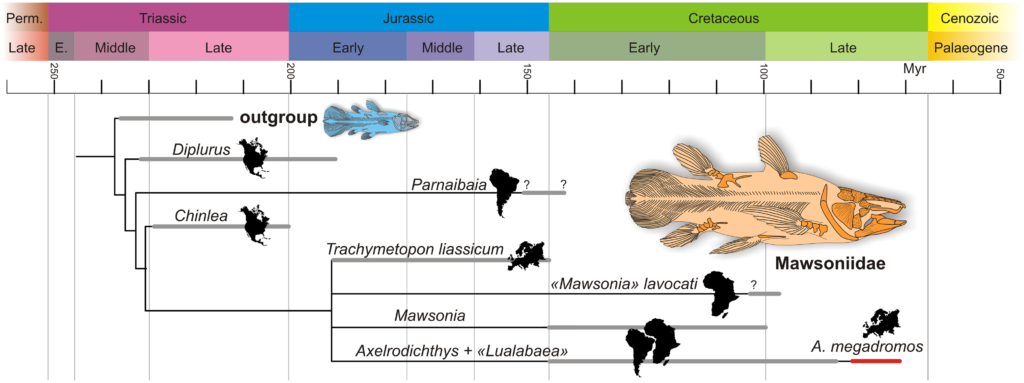@WFS,World Fossil Society,Riffin T Sajeev,Russel T Sajeev
Abstract
Coelacanths are iconic fishes represented today by a single marine genus. The group was a little bit more diversified in the Mesozoic, with representatives in marine and continental environments in the Late Cretaceous. Here we describe isolated skull bones of the last know freshwater coelacanths found in several fossil sites from the Early Campanian to the Early Maastrichtian of Southern France (in the Departments of Aude, Bouches-du-Rhône, Hérault, and Var). The sample does not allow distinguishing different species, and all material is referred to Axelrodichthys megadromos Cavin, Valentin, Garcia originally described from the locality of Ventabren in Southern France. A reconstruction of the skull is proposed. Previously unrecognized features are described, including parts of the postparietal portion of the skull, of the suspensorium and of the mandible. The new data confirm the assignation of the species to the mawsoniids, and more specifically to Axelrodichthys. A cladistic analysis scoring new character states provides a similar topology than a previous analysis, i.e. A. megadromos is placed in a polytomy with Axelrodichthys araripensis and Lualabaea lerichei, two species from the Early Cretaceous of Brazil and from the Late Jurassic of the Democratic Republic of the Congo, respectively. A. megadromos appears to have been restricted to freshwater environments, to the contrary of oldest Western Gondwanan representatives of the family that were able to live in brackish and marine waters. A. megadromos is the last representative of the mawsoniids and its occurrence in Europe is probably the result of a dispersal event from Western Gondwana that happened somewhen in the Cretaceous. Based on the available data, the mawsoniids went extinct in the mid-Maastrichthian, i.e. before the end-Cretaceous mass extinction. But it is possible that the fossil record of this family, which has been only recently recognized in Late Cretaceous European deposits, will geographically and stratigraphically widen with further discoveries.

Axelrodichthys megadromos, Velaux—La Bastide Neuve.Parasphenoid (MMS/VBN.09.001 G) in ventral view. Thick arrow indicates anterior. Abbreviations: lat.gr, lateral groove; med.gr, medial groove.

Simplified time-scaled phylogeny of the Mawsoniidae with their continental distribution (silhouettes).The trichotomy between three species of Mawsonia (M. tegamensis, M. braziliensis and M. gigas) and between two species of Axelrodichthys (A. araripensis, A. megadromos) and Lualabea are not figured.
Citation: Cavin L, Buffetaut E, Dutour Y, Garcia G, Le Loeuff J, Méchin A, et al. (2020) The last known freshwater coelacanths: New Late Cretaceous mawsoniid remains (Osteichthyes: Actinistia) from Southern France. PLoS ONE 15(6): e0234183. https://doi.org/10.1371/journal.pone.0234183
Editor: Giorgio Carnevale, Università degli Studi di Torino, ITALY
@WFS,World Fossil Society,Riffin T Sajeev,Russel T Sajeev



 June 13th, 2020
June 13th, 2020  Riffin
Riffin  Posted in
Posted in  Tags:
Tags: 